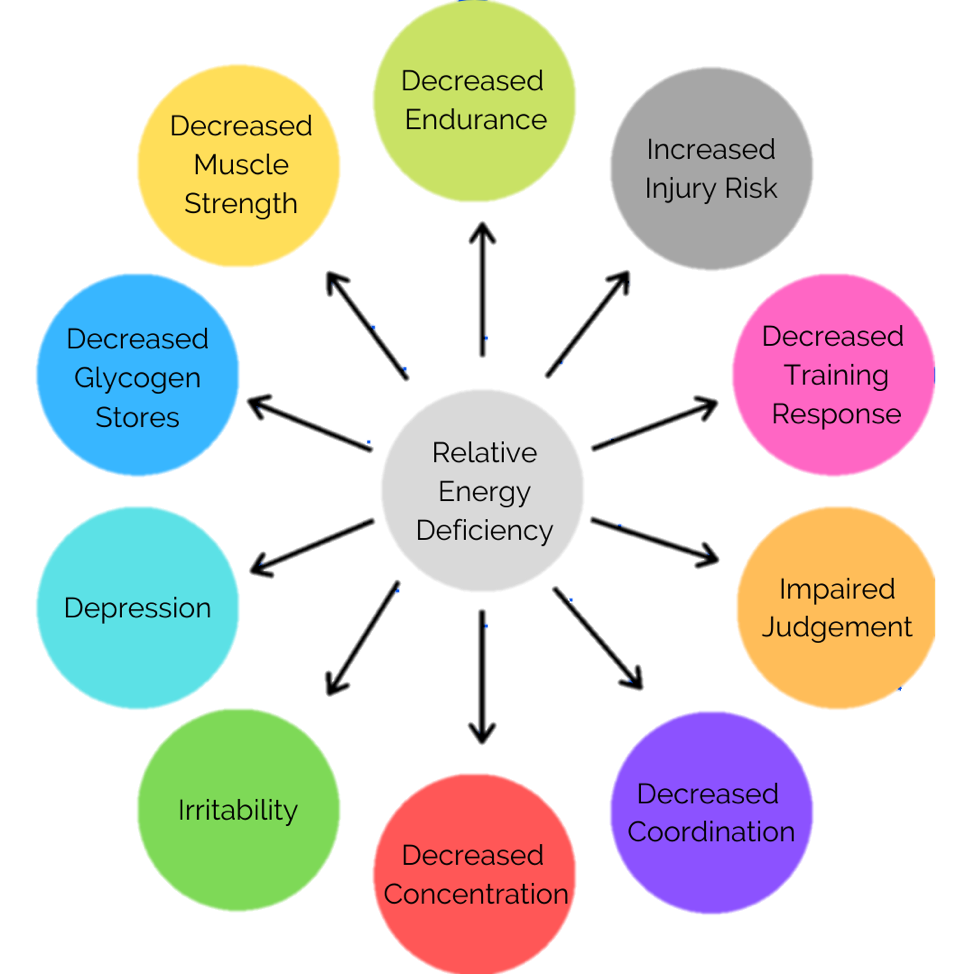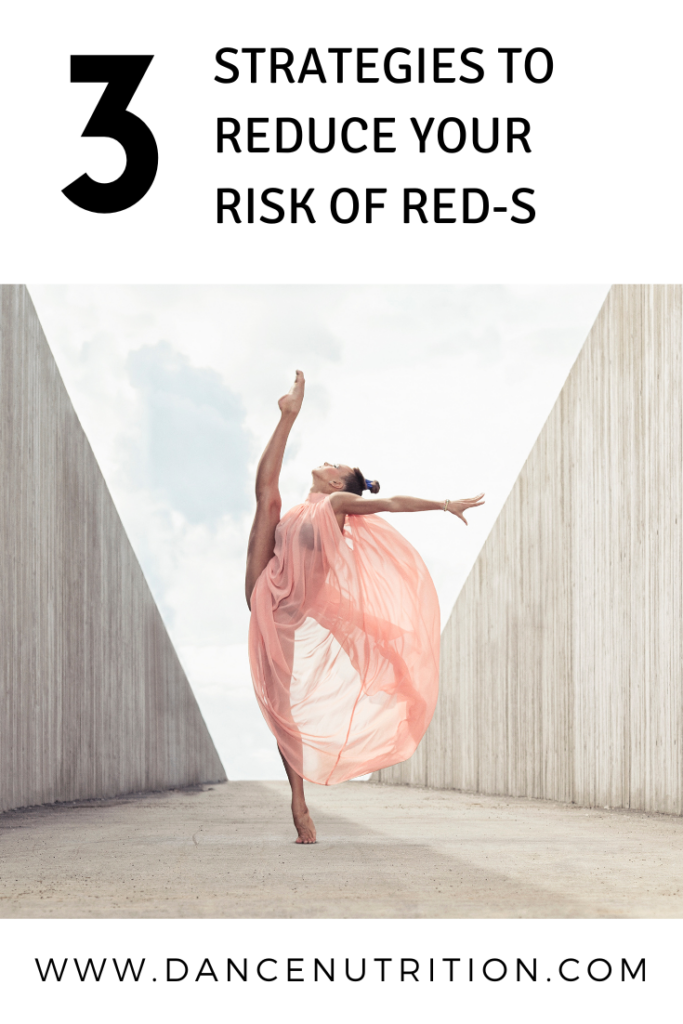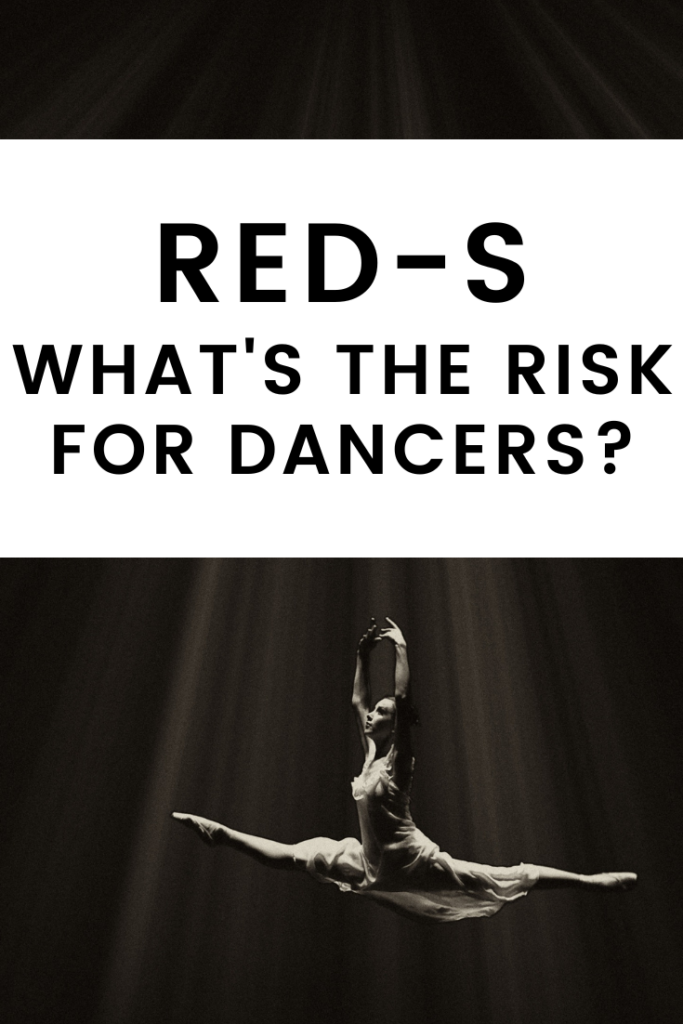A dancer’s demanding schedule introduces challenges that span beyond their capabilities inside the studio. Relative Energy Deficiency in Sport or “RED-S” encompasses a syndrome that runs rampant throughout the dance industry. RED-S results from low energy availability. Since calories are our body’s #1 source of energy, low energy availability occurs when not enough calories are available to support both your physical activity (AKA your dance schedule) and your metabolic activity.
What is RED-S and what happens when a dancer develops it?
It wasn’t until 2014 that the term “RED-S” surfaced from an updated consensus regarding the health of athletes (and here is the most updated version). Prior to this, the Female Athlete Triad was used to represent 3 realms that, when intertwined, result in injury. To break it down, if you’re not eating enough and/or you’re exercising excessively, then you risk a series of hormonal imbalances that result in weak bones. Since weak bones are unable to support the heavy load of a dancer’s training, injuries like stress fractures arise.
RED-S on Dancer Health
Relative Energy Deficiency in Sport (RED-S) includes a broader range of negative health consequences that result from low energy availability. Some of these include:

- Appetite dysregulation
- Impaired digestive function
- Impaired bone health
- Mindset challenges— difficulty with focus and concentration
- Impaired blood health
- Sleep disturbances
- Reduced immunity
- Impaired cardiovascular function
- Infertility
- Increased risk for bone injury
RED-S on Dancer Performance
The challenges mentioned above directly impact a dancer’s craft:
- Challenges with muscle recovery
- A lack of concentration
- Chronic fatigue
- Irritability
- Depression
- Loss of muscle strength
- Decreased coordination
- Decreased training response
- A lack of motivation
- Increased risk of burnout
Amenorrhea in Dancers
An irregular menstrual cycle had and continues to be a key identifier in the diagnosis of RED-S. According to the Royal College of Obstetrics and Gynaecology, primary amenorrhea (the complete absence of a period) is when periods have not started by age 16. Secondary amenorrhea is when already-established periods stop for 6+ months (3+ months in those with established regular cycles). While many factors can impact period health, functional hypothalamic amenorrhea (FHA) is a type of secondary amenorrhea that is often experienced by dancers in relation to energy imbalance. These conditions are red flags of Relative Energy Deficiency in Sport and warrant consultation with a Registered Dietitian Nutritionist and medical doctor.
Think about it like this… Despite how fatigued you might feel after a long rehearsal, your body can continue to push through. To prioritize and support this energy expenditure, your body reduces the energy available for other metabolic processes not needed for immediate survival: reproduction and subsequent hormone production (mainly estrogen and testosterone) diminishes. Since estrogen and testosterone both play a role in your body’s bone production, bone health suffers.
Do Male Dancers Need to Worry About RED-S?
Absolutely. The hormone imbalances that result from energy availability can negatively impact all dancers, regardless of sex. Arguably, biological male dancers can be at greater risk if red flags are not identified quickly. Without regular menstruation as an obvious sign, it can be easier to miss red flags of low energy availability. It’s recommended that all dancers consult with a qualified clinician (Registered Dietitian Nutritionist) to help in the evaluation of their risk for RED-S.
Why Are Dancers Most At Risk for RED-S?
Low-calorie diets are one culprit for the energy shortage, along with those demanding dance schedules. Simply put, if you’re not fueling your body with enough food, then you’re at risk for developing RED-S.
Despite a changing industry, many dancers are still immersed in a world where antiquated body ideals are at the forefront of their school’s or company’s priorities. When compared to the general population, dancers are more prone to strive for thinness and as a result, remain at a higher risk for the development of eating disorders. In fact, dancers remain three times more likely to develop an eating disorder, with that risk even higher among ballet dancers.
While RED-S poses major risk for dancers, the good news is that it’s completely preventable. You can take critical steps to reduce your risk of RED-S and ultimately, your risk of physical and mental injury. Let’s discuss 3 important steps to consider to ensure that your body has enough energy for not only your dancing but also for your metabolic functioning.
How Can Dancers Reduce Their Risk of RED-S?
#1: Eat Enough
A dancer’s diet should focus on abundance and variety. Build a meal plan that consists of at least 3 meals and 2 snacks, each dispersed throughout your morning, afternoon, and evening. If you’re struggling to find time between classes and rehearsals, then consider packable snacks like bars, fruit, and nuts. Remember, your priority is a successful performance and your energy availability plays a major role in that performance!
#2: Rest More
Does your dance schedule lend time for adequate rest? Are you sleeping at least 7-8 hours each night? The CDC recommends 8-10 hours of sleep for teens and 7 or more hours per night for adults. Rest is an essential part of a dancer’s training as it allows for muscle recovery, reduces the risk of injury, and improves mental clarity. To learn more about the role of sleep in a dancer’s performance, read this article.
#3: Seek Support from Licensed Professionals
Consulting with a Registered Dietitian Nutritionist who is familiar with the unique needs of a dancer is a major plus. In my work with dancers, not only are we prioritizing adequate meal- and snack-planning but also, working to dismantle dancer diet culture and the many misconceptions that often lead dancers to restrictive eating habits. Working with a mental health therapist can also help to deconstruct unsupportive food and body thoughts.




